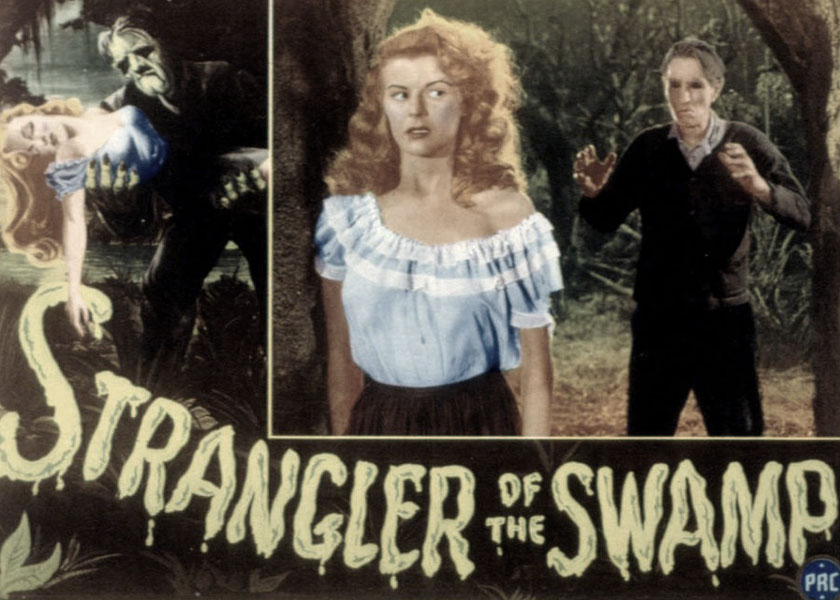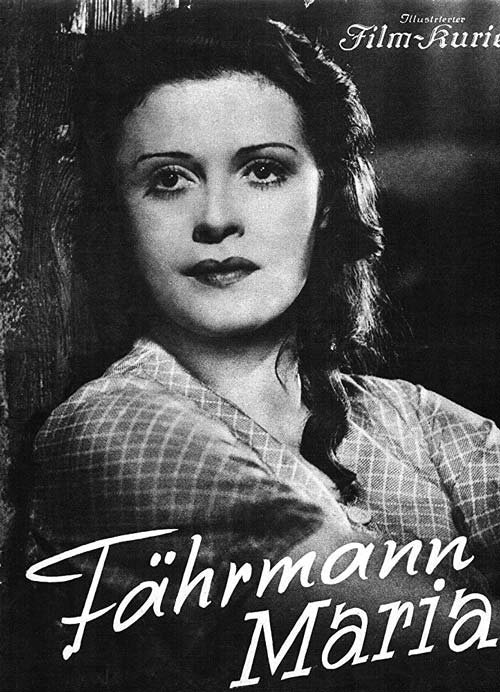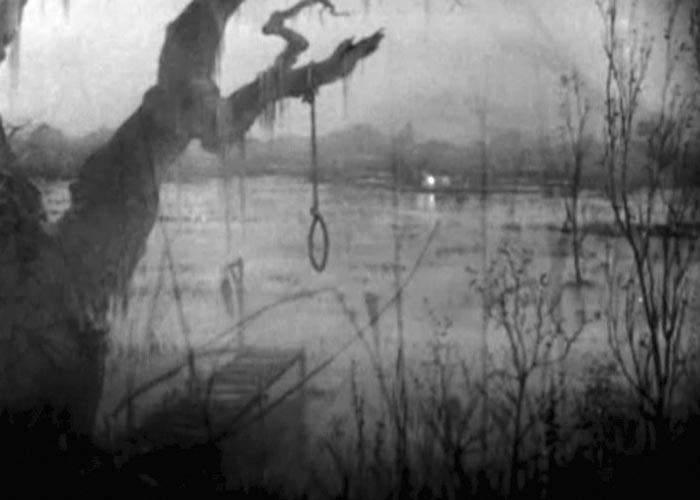Producers Releasing Corporation (PRC) was a Poverty Row studio located near the bottom of the Hollywood food chain that operated from 1939 until 1948. PRC films were short (usually around one hour and change), cheaply made (Detour, perhaps the studio’s most famous release, had a budget of around $30,000!), and mostly pretty bad. A sampling of PRC releases might include Arizona Gang Busters (1940), The Mad Monster (1942), and Gas House Kids (1946). Interestingly enough, all three of these films were helmed by the same man, Sam Newfield. Newfield, one of the most prolific directors of all time, happened to be the brother of the head of PRC, Sigmund Neufeld.
Remarkably, the studio did produce an occasional higher-quality movie. Most often these were directed by cult figure Edgar G. Ulmer, and include the aforementioned Detour, Strange Illusion (1945), Bluebeard (1944), and Her Sister’s Secret (1946). While not helmed by Ulmer, Strangler Of the Swamp is nonetheless noteworthy. Director Frank Wisbar (Franz Wysbar) was a German expatriate who fled his native land in the late 1930s, presumably to escape Hitler, and restarted his career in America. He did not get his first US directing credit until 1945, for Secrets Of a Sorority Girl, released by…you guessed it…PRC. Strangler of the Swamp was his next effort, followed by several more low-budget features. Finding little success with films, Wisbar, as did so many of his colleagues, turned to television. From 1950-1955 he was associated with Fireside Theater (also called Jane Wyman Presents), the first successful filmed series on American TV. Wisbar directed and/or produced many episodes of this dramatic anthology series and even served as host for the 1952-53 season. By 1957 he was back in Germany, where he directed thirteen features, the last of which was released in 1967, the year of his death.

Strangler of the Swamp is set in a small, rural community which is being haunted by the ghost of a man who was hastily tried, convicted, and executed for a murder he didn’t commit. The phantom (Charles Middleton) has sworn vengeance on those whom he feels are responsible for his fate; this seems to include every adult resident of the town and all their offspring. The ghost frequents an adjacent swampy area which is traversed by a man-powered ferry. Needless to say, the local citizens are terrified of the malignant spirit and avoid the swamp as much as possible.
At the beginning of the film the ghost appears to the old ferryman who, we learn later, is the real murderer. The old man, overcome with fright, succumbs, and the town is left without ferry service. Enter Maria (Rosemary La Planche), who turns out to be the old man’s granddaughter and has come to take over his position, which seems to be a sort of family inheritance. It’s clear that Maria regards the swamp and village as her home and is not going to be scared off by any spook, despite warnings from her neighbors. She becomes friendly with the son (Blake Edwards) of the local headman (Robert Barrat). Friendship grows into love, and when the son is made deathly ill by the phantom, Maria offers her life in order to save that of her lover. Maria’s sacrificial offer mollifies the ghost, and the spell is broken. The phantom seems to fade away, the lovers are united, and peace and tranquility is restored to the settlement.
Top-billed Robert Barrat was a prolific character actor from the early 1930s through the early 1950s. He specialized in villains both serious, like Barbara Stanwyck’s scumbag father in the Pre-Code sizzler Baby Face (1933), and comic, such as the chief nasty in the Marx Brothers’ Go West (1940). In Strangler of the Swamp, however, he plays a solid citizen and a loving father. I’d guess that it’s the only time in his long career that he ever got top billing in a feature-length film.
Blake Edwards’s career as an actor was brief and not too successful, but he later came to be one of Hollywood’s real movers and shakers as a producer and director, with blockbuster hits like Breakfast at Tiffany’s (1961), The Pink Panther (1963), 10 (1979), and Victor Victoria (1982). His later films frequently starred his second wife, Julie Andrews.
Rosemary La Planche, Miss America of 1941, had an even shorter and less successful acting career than Blake Edwards. Strangler of the Swamp was one of her few credited screen appearances. By 1949 she had retired from the screen, married, and had two children. Her performance in Strangler of the Swamp may be best described as 'adequate.'
Charles Middleton achieved screen immortality as Ming the Merciless in the Buster Crabbe Flash Gordon serials, although he appeared in countless other films. His broad acting style and fruity delivery works well for his role as the phantom.
Contributing to the success of Strangler of the Swamp was the setting. Filmed entirely indoors on studio sound stages, artificial fog is used liberally to both enhance the spooky atmosphere and hide the cheapness of the sets. Both goals were achieved, and the film works well despite its low budget and the limitations of the talent involved, both in front of and behind the camera.
It turns out that Strangler of the Swamp is a remake of Fährmann Maria (Ferryman Maria), a film produced in Germany ten years earlier. Fährmann Maria was also directed by Frank Wisbar and, while there are many similarities between the two movies, there are also some striking differences. While Strangler of the Swamp is a thriller with supernatural overtones, Fährmann Maria may be best described as a romantic fantasy with supernatural overtones, highly reminiscent of Fritz Lang’s 1921 silent masterpiece Der müde Tod (Destiny).
The supernatural being in Fährmann Maria (as in Destiny) is not a vengeful spirit wandering in a lonely swamp, but Death Himself, who appears twice in the film, as a mature, white-haired, stern-visaged man dressed in black from head to foot. He materializes early in the story to claim the life of the old ferryman, who has not committed murder or done anything else wrong. It is just his time to go.
The old man’s death leaves the ferry without a tender, since nobody in the adjacent village wants the position. Enter Maria (Sybille Schmitz), who is not related to the deceased ferryman and has no connections to the area. She is a wanderer, having no homeland. The concept of homeland (heimat) is a recurring theme in the movie. One wonders how it resonated with German audiences in 1936. Maria is looking for work, and gladly takes the job as ferryman, despite its hardships and loneliness.

Presently a wounded young man (Aribert Mog), clearly a soldier, appears at the other end of the ferry line, striking the plowshare which signals Maria to come. She ferries him across the water as a menacing group of horsemen appears in pursuit. She ignores them and takes the young man into her cabin, where she tends his wounds. Later, while nursing him, the plowshare is again struck. Maria responds; waiting for her is the same apparition who visited the old man at the beginning of the film. He has come for the wounded soldier. Maria distracts Death by offering to dance with him at a village celebration. There they twirl together, much to the astonishment of the local inhabitants. Maria then leads the way back to her cabin, passing through the swamp. Thinking that he will now claim the life of his victim, Death follows her. But Maria knows her way through the bog and her companion does not. She leads him into an area of quicksand and the Grim One, with a look of amazement on his face, slowly sinks and disappears into the muck!
Maria, having thwarted Death (at least temporarily), returns to her shack and nurses her wounded soldier back to health. Together they cross on the ferry one last time and set off for his native country, where, at last, Maria will find her own homeland.
Fährmann Maria differs from Strangler of the Swamp in ways other than plot and characterization. The German film obviously had a much larger budget than the American, so there was no need to disguise cheap sets with manufactured fog. Most of Fährmann Maria was shot outdoors, in either full sunlight or (seemingly) bright moonlight. The swamp is real and no less oppressive than the one in Strangler, even without the fog.
Sybille Schmitz was a fairly big star in 1936, but her dark beauty did not fit the Aryan stereotype of feminine pulchritude, and her career faded during the World War II years. She was unable to reattain her position after the War, and committed suicide by barbiturate overdose in 1955 at age 45. Her leading man, Aribert Mog, also died young, but under quite different circumstances. Mog was an enthusiastic Nazi and supporter of Hitler. Fittingly, perhaps, he was killed in 1941 while fighting with the German Army during its disastrous invasion of the Soviet Union. He was 37.
While few would describe either Strangler of the Swamp or Fährmann Maria as landmarks in the history of cinema, both are interesting and well-made films and worthy of discussion and appreciation.
- Strangler of the Swamp
- 1946
- Producers Releasing Corporation (PRC)
- Directed by Frank Wisbar
- Screenplay by Frank Wisbar
- Starring Robert Barrat, Rosemary Le Planche, Blake Edwards, Charles Middleton
- Fährmann Maria
- 1936
- Pallas Film
- Directed by Frank Wisbar
- Screenplay by Hans Jurgen Nierentz, Franz Wisbar
- Starring Sybille Schmitz, Aribert Mog, Peter Voß

